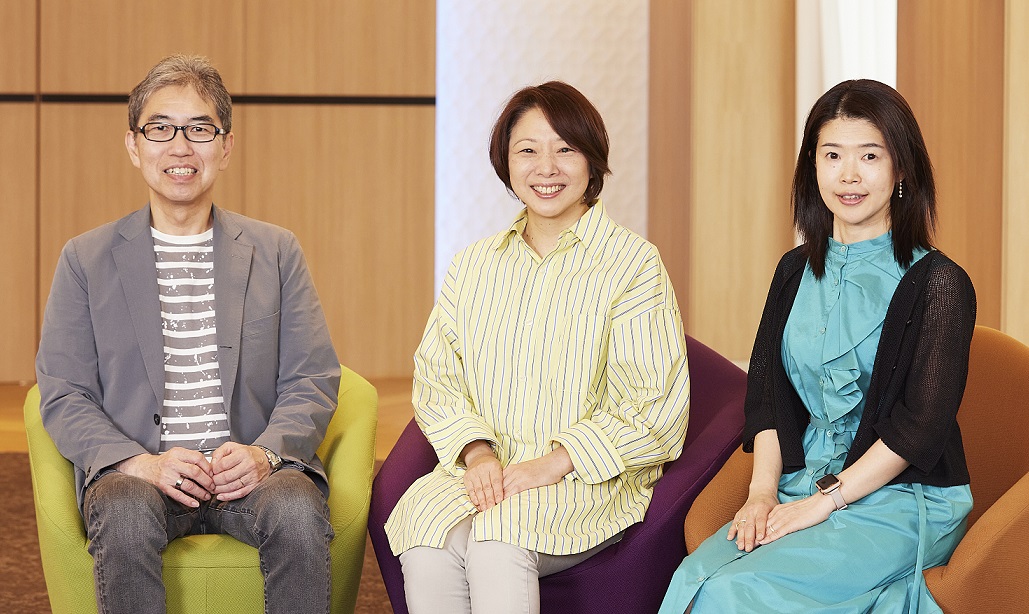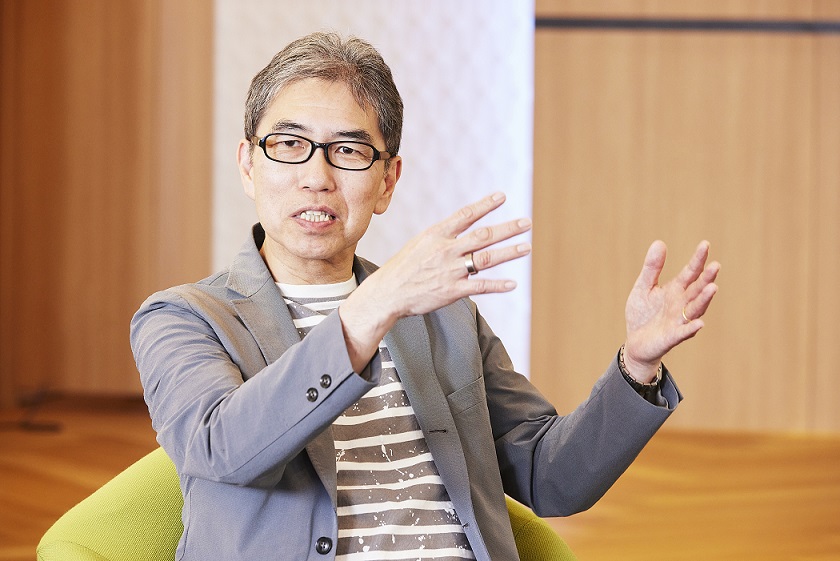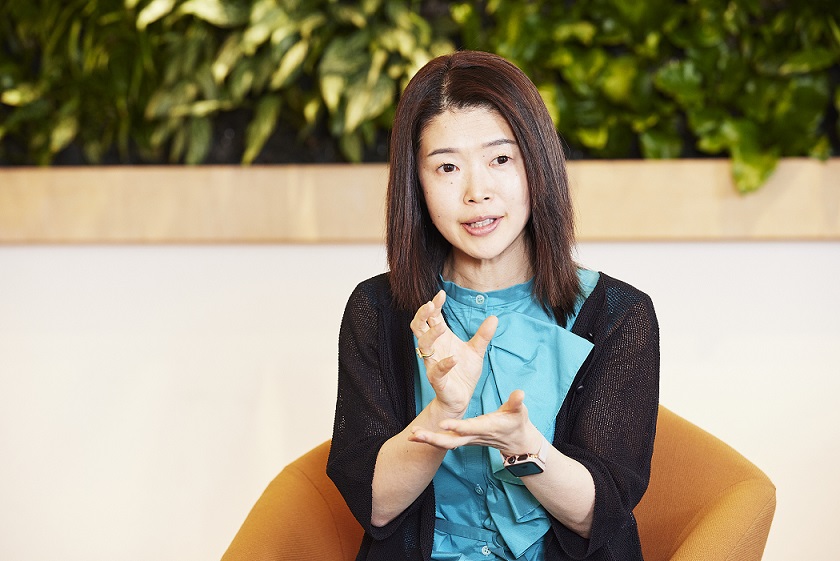Human Capital Management Dialogue
Collaboration between the CEO and CHRO Accelerates the Speed of Management

(Left in the photo)Hidehito Takahashi: Chief Execut ive Off icer (CEO)
(Center in the photo) Hiroko Ozawa: ESG/Responsible Investment Research Center Head, Japan Shareholder Services Ltd.
Researcher at People Analytics & HR Technology Association
(Right in the photo) Nori Imai: Chief Human Resource Officer (CHRO)
What should be the approach to management and human resource development to create co-creative talent? We invited Hiroko Ozawa, who has a deep understanding of human capital management, to hold a dialogue with CEO Hidehito Takahashi and CHRO Nori Imai.
(The dialogue was held in the Resonac conference room on May 11, 2023.)
What Are the Trends and Essence of Human Capital Management?
I believe there are two main approaches Japanese companies take toward their human capital currently. One approach is companies that are rushing internally, driven by the need for disclosure. With the advent of a human capital boom, companies are trying not to miss out and striving to somehow make an appeal for what they are doing. The obligation to disclose in securities reports has become a significant trigger, and many companies are pondering how to respond.

I completely agree. Japanese companies have traditionally had a package of the four elements of mass hiring of new graduates, academic elitism, a seniority system, and lifetime employment, and I believe this package led to the stagnation of Japanese companies and the Japanese economy after the bubble burst. I do not think Japan can regain its vitality unless this package is dismantled.
I don’t guarantee lifetime employment to new employees. Instead, I tell employees that “I will make sure you become a valuable asset that can be useful in any company.” I believe that achieving this is what human capital management is all about. I have experience working in major Japanese companies and top global companies, and I feel that Japanese companies should learn from the human capital management of top global companies. Although many Japanese companies have strongly focused on ensuring transparency in promotions, raises, and maintaining equality, I personally find this approach unsettling. Whether Japanese companies will try to bridge this gap in the future is uncertain. Some companies might try to change, and others might not. However, in the long run, there might be a shakeout.
Considering this, it means that it is necessary to think about how to bring out individual abilities and how to form types of teams that are different from those up until now. We might need to consider the diversity of combinations of the good qualities that each individual has, and to consider the division of roles.
Hierarchical command systems based on traditional hierarchies can’t solve our problems. We need to genuinely engage with each individual, bringing out their strengths, and if we don’t treat people appropriately, management will suffer. I feel that this is becoming the fundamental challenge now.
The term human capital management seems to have taken on a life of its own, and it is difficult to see the essence of the concept. It is a given that people are important, and the very idea of enhancing growth strategies and the business portfolio has already become a commodity. While every company may have a medium-term management plan and an admirable approach, they are all essentially the same. What differentiates companies is whether they have a management team that can execute those plans and whether they have developed human resources to support that management. In this sense, we view human resource development as the shortest path for maximizing corporate value.
I agree. Among the various forms of management resources, only human capital has a will. Because each person acts based on his or her own will, it takes time and involves difficulty to achieve results as an organization. The sum of each person’s will becomes the individuality of an organization, which serves as the source of the organization’s competitiveness. In other words, the individuality of an organization is determined by the multiplication of the will of each individual member.
What Kind of Talents Are Needed to Become a “Co-creative Chemical Company?”
We have clearly defined the talents who support the Resonac Group as a “Co-creative Chemical Company.” One is a talent who can work while involving the people around him or her, literally co-creating with them. Another is an autonomous talent who can take the necessary action on their own, rather than waiting for instructions.In order to develop such talents, we place importance on four values: “Passionate & Results-Driven,” “Open Minds & Open Connections,” “Agile & Flexible,” and “Solid Vision & Solid Integrity.” Ms. Imai and I continue to tell employees at events such as town-hall meetings at each business site, “Let’s aim to be people who strongly hold these values and are capable of taking action.”

Imai
I believe that autonomy is based on having passion. The will to change society through the power of chemistry, the conviction that the Resonac Group can do it, and the passion to make sure it gets done are important. It is important to extend this passion to other units and other companies, and not just your own unit.
The Resonac Group’s style is to allow people to act freely and autonomously based on their values, with the Purpose as the key and the Values that are the mode of action to achieve the Purpose as the basis of their decisions. We are trying to ensure that this style is first thoroughly implemented as an action of the management team, and then gradually extended to all employees. We hold workshops at each workplace to discuss what the Purpose is at the workplace and what it means to demonstrate our Values, and receive feedback and clarification on how we are evaluated, so that we can make the purpose and values a personal concern and put them into practice. The ability to gain management experience in different businesses based on shared values and a shared language is a strength of the Resonac Group that also fosters employee growth.
Indeed, for chemical manufacturers like the Resonac Group with diverse business domains, it’s easy to imagine they might fall into vertically segmented organizations where each business unit develops its own customs and values and specializes in its own particular area of expertise. I believe that new business opportunities can be created by having a shared language as you have explained, recognizing differences in ways of thinking, and transcending boundaries. We might see a new paradigm if such challenges bear fruit and more people get excited about creating value across business units.
From this discussion, it’s clear that Resonac Group has explicitly defined its purpose and values, and is trying to spread them throughout the company and incorporate them into its human resources system and evaluations. The numerous town-hall meetings and roundtables that are held and the intent of the management team to communicate directly with all employees are truly commendable.
Many Japanese companies seem to just create and announce a purpose but fail to clarify how they aim to link this purpose with daily business operations and tasks, what kind of people they are looking for, and how to reflect this in actions and decisions, and there seems to be a lack of clear implementation in many cases. It’s quite a waste given the time and effort invested. Needless to say, to link the purpose to maximizing corporate value, it is necessary to instill it and link it to business activities. Rather than addressing a stated purpose as an obligation, it won’t empower the organization unless employees should see the potential of finding a connection to their own work and have the will to take initiative.
In this respect, the Resonac Group has a well-crafted grand design of purpose and values, and they’re addressing everything from individual actions to value judgments. I felt that this is a significant strength.
Collaboration Between the CEO and CHRO Accelerates the Speed of Management
I believe the strength of the Resonac Group is that both the CEO and the CHRO are firmly committed to human resource development and human resource strategies. If there were just one of them, real reform would be a challenge. The reason I can commit to HR to this extent is that we operate the business as a team. Goals related to the portfolio, business reform, and strengthening the management foundation are shared at the management level, and it is possible to delegate things entirely to business unit heads and CXOs.
To return to the topic of human resources and cultural change, I have a rough idea of what awaits me in the future through my accumulated experiences. Of course, while I won’t say that everything is correct about my image of the future, we discuss talents with a shared language based on common values, and we aim to build on successes with an excellent team that demonstrates teamwork and maintains a sense of tension. I envision achieving success in 10 years by improving and adjusting our approach year by year. I will never waver from this belief in the future. Decision-making is quick with the CHRO as we share the same objectives. It’s common to discuss the next measures with the CHRO on the spot during roundtable discussions with employees.
Indeed, it’s surprising how aligned my vision is with Mr. Takahashi (laughs). Mr. Takahashi is a visionary leader skilled at defining the why and the what. While I serve as a sounding board for the why and what, my role is to think about the how, and I’m currently implementing the reforms I’ve always wanted to make and saw as necessary. The human resources domain is evolving at a surprisingly rapid pace. For example, while I sometimes consider the necessary processes for driving change based on adult development theories, in the future, we won’t just use psychology but also approaches from neuroscience. Changing a person’s mindset and achieving a state in which the purpose and values are fully embodied isn’t easy and takes time. Firstly, based on hypotheses and while obtaining feedback, while consistently applying a data-driven improvement cycle as scientifically as possible, I want to achieve a transformation with the participation of everyone through persistent, direct dialogue with employees.

Ozawa
The collaboration between Mr. Takahashi and Ms. Imai, who share the same values and goals, is truly wonderful. Unlike the two of you, I suspect that CEOs and CHROs in not a few Japanese companies lack a common goal setting based on shared business strategies or are unable to collaborate effectively. I believe the teamwork between the CEO and CHRO ensures that the top management’s vision reaches all employees. Once town-hall meetings or roundtable discussions are over and employees return to their daily tasks, their actions and words are heavily influenced by the evaluations of their immediate superiors. I think future challenges will involve getting leaders in the field and middle management on board. I urge you both to overcome these challenges with your teamwork skills. I am very much looking forward to your future growth.
